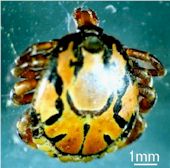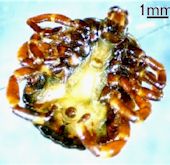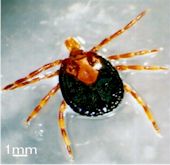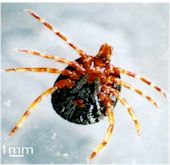
Male: Amblyomma hebraeum

Male: Amblyomma hebraeum

Female: Amblyomma hebraeum

Female: Amblyomma hebraeum
|
|
African Bont Tick
 Male: Amblyomma hebraeum |
 Male: Amblyomma hebraeum |
 Female: Amblyomma hebraeum |
 Female: Amblyomma hebraeum |
| Common Name | African Bont Tick |
| Scientific Name | Amblyomma hebraeum |
| Size | A hebraeum males are 4.2–5.7 mm long and A. hebraeum females are 5 mm long |
| Colour | A.hebraeum has a variety of colours |
| Description | A.hebraeum belongs in the family of Ixodidae (hard tick). Hard ticks
have a dorsal shield (scutum) and their mouthparts (capitulum) protrude
forward when they are seen from above. Amblyomma ticks are large
variegated ticks with long, strong mouthparts. The palps1 are long; the
second segment is twice as long as it is wide. Eyes are present and the
festoons2 are well developed. The males have no adanal shields, accessory
shields or sub anal shield. A. hebraeum males are 4.2–5.7 mm long, oval
ticks. The capitulum3 is long, with a rectangular basis; the lateral
margins are rounded and the posterolateral angles are rounded and
slightly salient. Palpal segment 2 is approximately three times as long
as palpal segment 3. The scutum is smooth and convex, with fine black or
brown spots and stripes on a pale greenish-white back-ground. The
posteromedian stripe is narrow and is knobbed anteriorly; it rarely
reaches the falciform stripe. The poster–accessory stripes are short and
well separated from the third lateral spots. The festoons, with the exception of the external festoons, are pale. The scutal eyes are small, slightly convex and circular. The ventral surface is dull greenish-yellow, with distinct ventral plaques and festoons with dark brown scutes (obsolete on the external one). The spiracular plate is moderately large and triangular, with rounded angles. The legs are dark brown, moderately stout, and have apical yellow banding at the distal end of each segment. Coxa I has two unequal spurs, coxae II and III contain salient ridges, and coxa IV has a short stout spur. The tarsi are short and abruptly attenuated. Unfed A. hebraeum females are 5 mm long; engorged females can be up
as long as 20 mm. The dorsum is dark greenish–brown or black, punctate
and striate. The capitulum is 2 mm long, with a rectangular basis,
convex lateral margins and slightly salient posterolateral angles. The
palpi are slender; segment 2 is slightly curved and is approximately 2.5
times as long as segment 3. |
| Habitat | Amblyomma hebraeum is often found in moderately humid, warm
environment. Unfed nymphs of A. hebraeum are found sheltered under
debris of the soil |
| Lifecycle | 3-host, female produces up to 20000 eggs that hatch between 4-13 weeks, depending on the circumstances. The larvae engorge 4-20 days and moult in 2-7 weeks. The nymphs engorge in 5-20 days and moult in 14- 60 days. Adult females engorge in 10-20 days |
| Disease Transmitted | African Tick-Bite fever caused by Rickettsia africae transmitted by a hebraeum. |
| Control | Measures used to exclude ticks of foreign origin from a country
include pre-export inspection and certification that the animals are
free of ectoparasites, quarantines during entry, and animals should be
treated with acaricides. In countries where A. hebraeum is already
present, acaricides can remove the ticks from the animal, but it does
not prevent reinfestation. Three-host ticks spend at least 90% of their
life cycle in the environment rather than on the host animal; ticks must
be controlled in the environment to prevent their wide spread in the
community. If ticks are already widespread in the community, extirpation can be almost impossible. Extirpation programs are based on animal identification and periodic acaricide treatment of livestock, as well as public education, surveillance, quarantines and movement restrictions |
1An elongated, often segmented appendage usually found near the
mouth in invertebrate organisms such as mollusks, crustaceans, and insects, the
functions of which include sensation, locomotion, and feeding.
2Ridges on the edge of the lower abdomen
3Head or mouthpart
[ Home Page ]